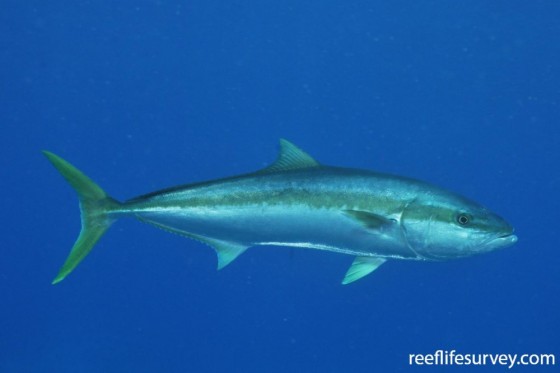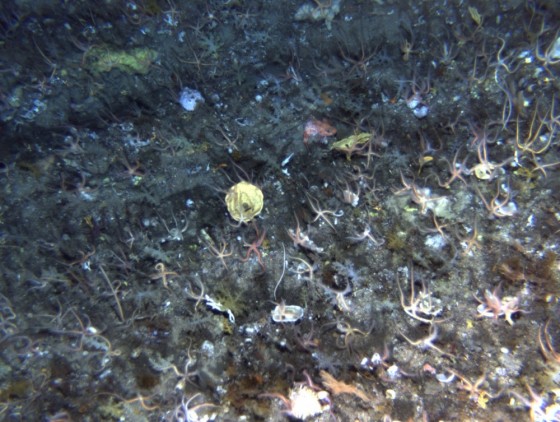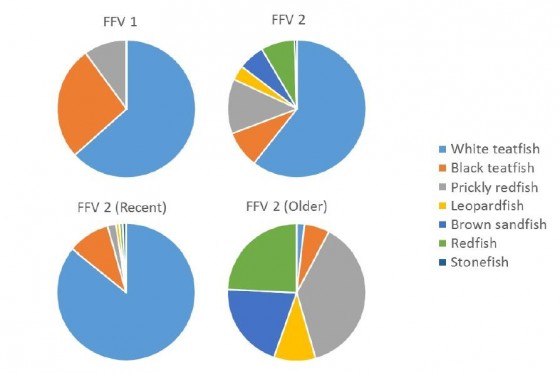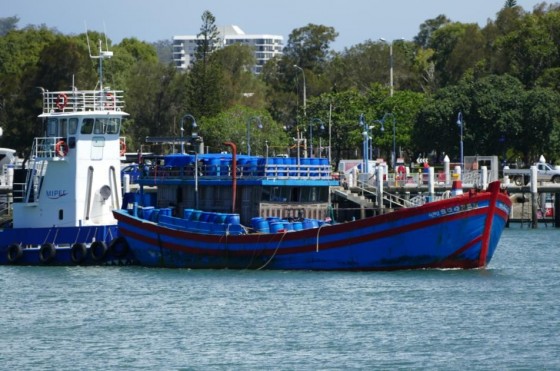Introduction - The important of science in management - Cod Grounds Marine Park - Cost effective monitoring - Sea cucumbers
Science is an important part of day to day marine park management. Science in marine parks helps improve knowledge across a wide range of topics such as:
- discovering what species of plants and animals are in our parks
- tracking changes in the coverage of habitats such as coral reefs and seagrass beds
- researching what people enjoy about our marine parks and how much human activity is happening in them
- how the parks contribute to local and regional economies
- the effects warming oceans and rising sea levels may have on biodiversity
- understanding ocean currents and sea temperature changes.
Parks Australia uses this information to make management decisions, report on the condition and effectiveness of the parks and to inform users and other interested members of the public about the parks. Science will continue to be very important for managing our marine parks successfully into the future.
The importance of using science to manage marine parks
Using and improving our knowledge and understanding of the natural, cultural, social and economic values of Australian Marine Parks and the pressures on those values is important to ensure we manage our reserves effectively.
Environmental research and monitoring in Australian Marine Parks provides information on the status of natural values and threatening processes, identifies trends through time, builds on historical knowledge and helps us develop our understanding of marine biodiversity within parks. We use this knowledge and understanding to inform decisions on avoiding, reducing, and managing human pressures.
We use an adaptive management framework to manage marine parks, which means we identify, collate, collect, analyse and use data and information to continuously improve management as knowledge evolves. A comprehensive monitoring, evaluation and reporting framework for all Australian marine parks will be developed during 2018 and 2019. This framework and the Parks Australia Science Direction Statement 2018–2022 will help guide science activities undertaken by or on behalf of Parks Australia over the coming years.
The purpose of the Science Direction Statement is to:
- encourage research and innovation aligned with Parks Australia’s long-term vision
and targeted to address our science priorities - facilitate effective partnerships with other organisations
- foster science engagement and collaboration with Aboriginal and Torres Strait Islander people
- communicate our science needs to the broader scientific community
- increase our use of citizen science as a valued contribution to science programs
and build community participation.
Park’s Australia’s marine science program is one of seven management programs established to support the implementation of network management plans. Alongside zoning schemes and other management arrangements, these programs will help deliver marine biodiversity conservation, as well as sustainable use and enjoyment outcomes. The marine science program is consistent with the overarching Parks Australia Science Direction Statement. It links in with the implementation of national science programs delivered under the National Marine Science Plan 2015-2015 and the National Environmental Science Program (NESP), which also help to address marine park science and management needs.
One of the ways we are increasing the state of knowledge of the natural values and pressures in our parks is through commissioned literature reviews. The first of these were done in 2010 , with a separate report for the Coral Sea and a later review for all 58 marine parks was done in 2017. These provide an important collation and understanding of existing public scientific information relevant to our parks.
There will always be the potential for obtaining more data, information and knowledge about our parks than there are resources to obtain it. We need to prioritise our science needs to ensure the limited resources available are used to greatest effect. This includes considering the:
- relative conservation value of the biodiversity asset or system
- pressures or threats acting on that asset or system
- adequacy of existing knowledge for effective management
- effectiveness of management treatments or response options in mitigating threats to an acceptable level.
Some examples of how scientific information can be used in management include:
- making decisions in permits and authorisations for activities such as commercial tourism, research and fishing
- predictive modelling of future scenarios and identifying emerging issues likely to affect park values (e.g. coral bleaching)
- studying the effectiveness of a zone type within a marine park with a view to reviewing management arrangements if necessary.
Case study: Cod Grounds Marine Park
The Cod Grounds Marine Park is located around seven kilometres off the New South Wales mid-north coast. It was established in May 2007 to protect marine biodiversity, in particular habitat and prey for the critically endangered East Australian population of grey nurse sharks (Carcharias taurus). All forms of fishing are prohibited in the park, which is a Marine National Park Zone.
Regular sampling of the fish diversity on rocky reefs in and around the Cod Grounds Marine Park improves understanding of whether the park is effectively supporting marine wildlife, including grey nurse sharks.
To help people follow the rules, a marker buoy was installed in the centre of the park in 2013 as a visual reminder and deterrent to fishers. Regular surface patrols of the park are conducted by New South Wales Department of Primary Industries that target popular recreational fishing periods throughout the year. A Parks Australia aerial surveillance program is also conducted at the same time.
From 2014–2016, Parks Australia commissioned Southern Cross University to undertake baited remote underwater video sampling inside and outside the marine park. The video device records fish attracted to a bag of bait using special underwater video equipment. It is left unattended in the water for around an hour.
The bait attracts a wide variety of fish and other marine animals, including some that are rarely seen, that may otherwise be scared off by researchers or live in areas unsuitable to be monitored using scuba diving.
In total, 92 baited remote underwater videos were deployed. The imagery filmed within the Cod Grounds Marine Park is compared to vision taken in comparable habitat outside the marine park. This comparison shows us if there is a difference in the species of fish and the abundance of fish inside and outside the park.
The researchers found that the park had significantly higher numbers of species and a higher abundance of fish compared to areas outside the park that are open to fishing. This includes species like snapper and yellowtail kingfish (Seriola lalandi), which are popular among commercial and recreational fishers. It also includes the species of fish that are prey for grey nurse sharks.
A total of 72 species of fish were recorded within the park. This included eight observations of grey nurse sharks, which complement other records for this shark using acoustic tagging and visual census data collected by the New South Wales Department of Primary Industry and CSIRO. Together, this data shows that there are more grey nurse sharks aggregating inside the marine park than outside.
The baited remote underwater video sampling provides evidence that the marine park management arrangements effectively support healthy marine wildlife, including grey nurse sharks. Ongoing monitoring will inform potential changes to education and compliance efforts required to maintain and improve these benefits generated by the park.
References:
Davies P., Jordan A., Ingleton T., Neilson J., Mesley E. (2008) Cod Grounds Commonwealth Marine Reserve: Swath survey and habitat classification. Final report to the Department of the Environment Water, Heritage and the Arts, Canberra.
Kelaher, B. (2016) Comparisons of fish assemblages and grey nurse shark prey in and around the Cod Grounds Commonwealth Marine Reserves. Final report to Parks Australia, Canberra.
Case Study: Developing cost-effective baseline and monitoring surveys in the South‑east Network
Tasman Fracture Marine Park
The Marine National Park Zone in the Tasman Fracture Marine Park is the only area of continental shelf habitat within the South-east Australian Marine Park Network that prohibits all forms of fishing. This provides the opportunity to study the effectiveness of this zone type in protecting shelf biota.
In 2013–15 multi-beam echo sonar, baited remote underwater videos and autonomous underwater vehicles were used to map bathymetry and habitats, fish, and sessile benthic biota (e.g. corals and sponges). Key outputs and findings (Monk et al. 2016) include:
- the first fine-scale 3D survey of the MNPZ and a nearby area outside of the park.
- Reef habitat is only a small proportion of the Marine National Park Zone. Small, isolated reefs rising from water depths of 100–140 metres occur on the north-west margin of the zone, and an isolated reef rising from depths of 80–140 metres occurs to the east of the Mewstone (a small rocky island).
- Reefs in 100–140 metres water depth in the north-west section of the Tasman Fracture Marine Park were mostly covered in soft corals and differ markedly from the typical sponge dominated cover typical of cool-temperate reefs in these depths.
- Model–based analyses suggest that there are significantly more southern rock lobsters within the marine park than in adjacent fished areas.
- Striped trumpeter, jackass morwong, ocean perch and morid cods increased in abundance inside the park compared to outside. Striped trumpeter and jackass morwong also showed increases in the abundance of large legal sized individuals.
- This information about the marine park will help us communicate its natural values and assess how effective the park has been in conserving biodiversity under the current management plan.
References
Monk, J., Williams, J., Barrett, N.S., Jordan, A., Lucieer, V.L., Althaus, F., Nichol, S. (2017). Enhancing the biological and reef habitat feature descriptions of Australia’s temperate-water AMPs: the shelf zone. A report to the National Environmental Science Program, Marine Biodiversity Hub. University of Tasmania. 282pp.
Monk, J., Barrett, N., Hulls, J., Hosak, G., Oh, E., Martin, T., Edwards, S., Nau, A., Heany, B., and Foster, S. (2015). Seafloor benthos, rock lobster and demersal fish assemblages of the Tasman Fracture Commonwealth Marine Reserve Region: determine the influence of the shelf sanctuary zone on population demographics. Tasman Fracture AMP Survey Progress Report 2, June 2015.
Monk, J., Barrett, N.S., Hill, N.A., Lucieer, V.L., Nichol, S.L., Siwabessy, P.J.W. and Williams, S.B. (2016a). Outcropping reef ledges drive patterns of epibenthic assemblage diversity on cross-shelf habitats. Biodiversity and Conservation, 25(3), pp.485-502.
Case study: Sea cucumbers in the Coral Sea
Australia’s Coral Sea Marine Park covers an area of nearly 1 million square kilometres off the Australian north-east coast. It borders the Great Barrier Reef Marine Park and contains 18 emergent coral reef systems and is recognised as a large, diverse, and globally significant coral reef domain.
The tropical sea cucumber is a commercially valuable species found within the Coral Sea. It plays an important ecological role in maintaining the health of reef ecosystems by removing organic matter, aerating sediment, redistributing nutrients, and improving productivity of algae. They also excrete calcium carbonate sand, an essential building block for reef building corals, shells of molluscs, crustaceans and other animals. Through this process, the sea cucumber may assist in counteracting some of the effects of climate change by replenishing calcium carbonate stores depleted by increasing ocean acidity (Skewes, 2017).
The Coral Sea’s Lihou Reef, and the Coringa Bank and Herald reefs were originally declared as ‘no take’ zones in 1982 and are now similarly protected as part of the Coral Sea Marine Park. Sadly, in recent years, significant amounts of sea cucumber have been illegally fished by foreign owned and crewed fishing vessels within these areas. While this is likely to have had a negative impact on the ecosystem health of these areas, it has also provided Parks Australia with an opportunity to better understand more about sea cucumbers in the Coral Sea.
In 2017, two foreign owned and crewed fishing vessels were apprehended in the Coral Sea by Australian Border Force and later towed to Gladstone with their illegal sea cucumber catch still on board. This provided an opportunity to scientifically investigate the catch.
Supported and funded by Parks Australia, and facilitated by the Australian Fisheries Management Authority, Australian Border Force, and the disposal contractor MIPEC (Gladstone); Parks Australia staff and a scientific expert on sea cucumber sampled the entire catch of one foreign owned and crewed fishing vessel and part of the catch of another. This investigation showed significant quantities of white teatfish (along with smaller percentages of black teatfish and prickly redfish) were being harvested illegally in the Coral Sea Marine Park. The report from this work can be found here: Skewes (2017).
A subsequent survey was done in April 2017 to estimate the density and population biomass of 10 commercial species within the Coral Sea Marine Park (including Coringa-Herald and Lihou reefs). It was important that the surveys were done in a way that allowed some inferences about their biogeography and population status to be made for the region broadly.
Surveys were done on eight reefs of the Coral Sea Marine Park with several reefs being surveyed for the first time. The primary objective was to provide information to quantify and assess the status of sea cucumber populations and supporting habitats on those reefs over a broad area of the Coral Sea; as input into the effective management of the Coral Sea Marine Park and the maintenance of its ecological values.
Outputs included:
- Estimates of relative abundance of sea cucumbers at selected sites
- Comparison of relative abundance of key economic species between fished versus non-fished sites
- Advice on the impacts of removal of key economic species
- Advice on utility of holothurians as ecological indicators in the Coral Sea (Skewes, 2017).
The study found that the density of most sea cucumber species, especially high value sea cucumbers, was relatively low throughout the Coral Sea survey area. Densities were particularly low at those reefs that have been subject to most fishing by the Australian CSSCF and by illegal foreign fishing vessels. This is especially true for the southern reefs and for sheltered deeper habitats areas that are expected to have higher populations of high value species. There is not enough information to determine the cause of these low densities, but it is thought to be most likely to be due to both a naturally low population and fishing pressure by illegal foreign fishing vessels in particular (Skewes, 2017).
The no take areas (Lihou Reef, Coringa Bank and Herald reefs) appear to have provided some protection for sea cucumber populations. This is probably due to high levels of compliance by Australian CSSCF to the closure and greater surveillance of these areas. The deep lagoon reef pinnacle habitats still have high densities of higher value species in particular that may have not been targeted in the past. These habitats are extensive in places and should provide some source of recruitment (Skewes, 2017).
The results of this study and collection and analysis of fishery dependent data from the CSSCF have provided information that Parks can use in understanding the status of natural values of the Coral Sea, and pressures or threats to those values. This is used in management areas such as compliance, ongoing monitoring and assessing management effectiveness.
References
Skewes T.D. (2017) Coral Sea sea cucumber catch sampling. Catch of two foreign fishing vessels, Coral Sea, February 2017. Tim Skewes Consulting. Brisbane.
Skewes, T.D. and Persson, S.I. (2017) Coral Sea sea cucumber survey, 2017. A report for Parks Australia. Tim Skewes Consulting. Brisbane.









